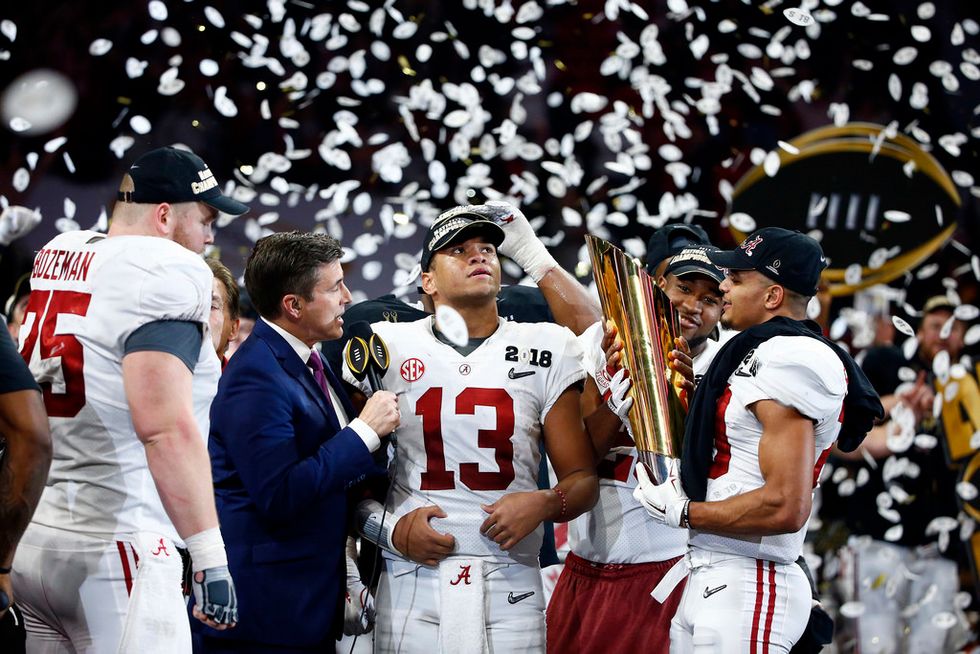November is one of the best months of the year if you're a college football season. As the regular season comes to a close, teams across the FBS are jockeying for bowl game invitation in December or January. And for about 10-12 teams, they're jockeying for a spot in the College Football Playoff.
By the first weekend of December, the top four teams of college football will be selected for the College Football Playoff, and bring a lot of controversy along with it. While the College Football Playoff was created to replace the controversial Bowl Championship Series (BCS), it still has a lot of glaring problems.
The problems range from the risk of human error/bias in the CFB Playoff Committee, changing guidelines on what is required for teams to get into the playoff, to great teams being left out of the playoff (as a Penn State fan like myself knows all too well), the list goes on and on. The College Football Playoff, while flawed, is still a good idea to determine a champion on the field instead of arbitrarily through traditional polls. Like many well-intended ideas, they can always be improved upon.
1. Expand the playoff field from 4 to 8 teams.
Here's a simple math problem: if you have four playoff spots and five Power Conferences in college football, how many teams are going to be left out of the playoff? Expanding the field from four to eight allows the champions from the ACC, Big Ten, Big 12, Pac 12, and SEC to get automatic bids into the playoff. The remaining three spots should be reserved for at-large teams.
In 2016, Penn State started the season with a 2-2 record before winning nine games straight to win the Big Ten Championship. They were left out of the playoff in favor of Ohio State, who Penn State beat in the regular season and didn't play in the Big Ten Championship game. Ohio State would go on to get stomped 38-0 by Clemson, while Penn State loss in a Rose Bowl shootout with USC, 52-49. Had the field been at eight teams in 2016, both Penn State and Ohio State would've got in.
The three at-large bids would also allow for Cinderella stories from the non-Power conferences to shine. Last season, Central Florida finished the regular season undefeated, but never got close to being considered. UCF was awarded a consolation prize of playing in the Peach Bowl, where they shockingly upset SEC power Auburn to go 13-0. As of now, UCF is still undefeated from last season and sits outside the top 10 of the playoff rankings. Teams like UCF should at the very least be able to test their might against Alabama or Notre Dame in the playoffs, what do they have to lose?
2. Make the guidelines to the playoff simpler to understand.
Let me get this straight, you're meaning to tell me that TCU didn't get into the 2015 College Football Playoff because the Big 12 didn't have a conference championship game, while Penn State was left out two years later despite winning in its conference championship game? What's always driven me and other college football fans crazy is that fact that there doesn't seem to be any concrete way of getting selected into the playoff.
The Playoff Committee needs to establish a set of guidelines that teams and fans alike can easily follow, instead of picking and choosing when certain parameters matter. Conference championships should be extremely valued, as well as strength of schedule, and overall record. While these parameters won't solve all of the issues with the playoff, it will at least make the Committee's argument for why a certain team was left out more justifiable.
3. Keep the New Year's Six bowls involved with the playoff.
College football is a sport that leans heavily on its old-time traditions, such as its bowl games. Under the current College Football Playoff format, the top tier bowl games or "New Year's Six" (Cotton, Fiesta, Orange, Peach, Rose, and Sugar Bowl) rotate on locations for the semi-final matchups, while the championship location is based on a bidding process similar to how the NFL determines its Super Bowl location.
For traditionalist like myself, I'd much rather watch the National Championship Game be played in the Rose Bowl than in an NFL stadium in San Francisco or Indianapolis. One of the few things I liked the old BCS system was that the National Championship site would rotate between the Rose, Sugar, Fiesta, and Orange Bowls. Because these bowl games are so interictal to college football, they should be ones hosting the National Championship Game.
In fact, why not get all of the New Year's Six bowls involved? On New Year's Eve and New Year's Day, have the quarterfinals held at the Rose, Sugar, Fiesta, and Orange Bowls. A week or two later, the semifinal matchups will be held in the Cotton and Peach Bowl. The National Championship Game would then be located in one of those six bowls in a given year.
4. On that note of bowl games, let's get rid of a few.
OK, I know I harped about how intertwined postseason bowl games are to the fabric of college football, but there is way too many of them. This bowl season, there are 40 bowls on the schedule from December 15th until January 7th. Out of the 130 teams in the FBS, 61% of them make it to a bowl game.
From the perspective of ESPN, its good to have a lot of bowl games since they televise most of them. But from a fan perspective, no one wants to watch 5-7 East Carolina take on 6-6 Louisiana Tech in the Cheez-It Bowl (unless you are a fan of those schools). Just in case you were wondering, yes that is a name of a bowl game this year, I wish I made that up.
Instead of 40 bowl games, reduce it down to 32 games, where the percentage of teams that do get invites is down to 49%. It means that bowls like the Cheese-It Bowl will be eliminated, and fans will be enticed to watch bowl matchups like Texas A&M vs. North Carolina State, or USC vs. Florida.Such changes to the structure of the College Football Playoff are necessary to address the problems within the system and ensure the long-term viability of college football itself.






















